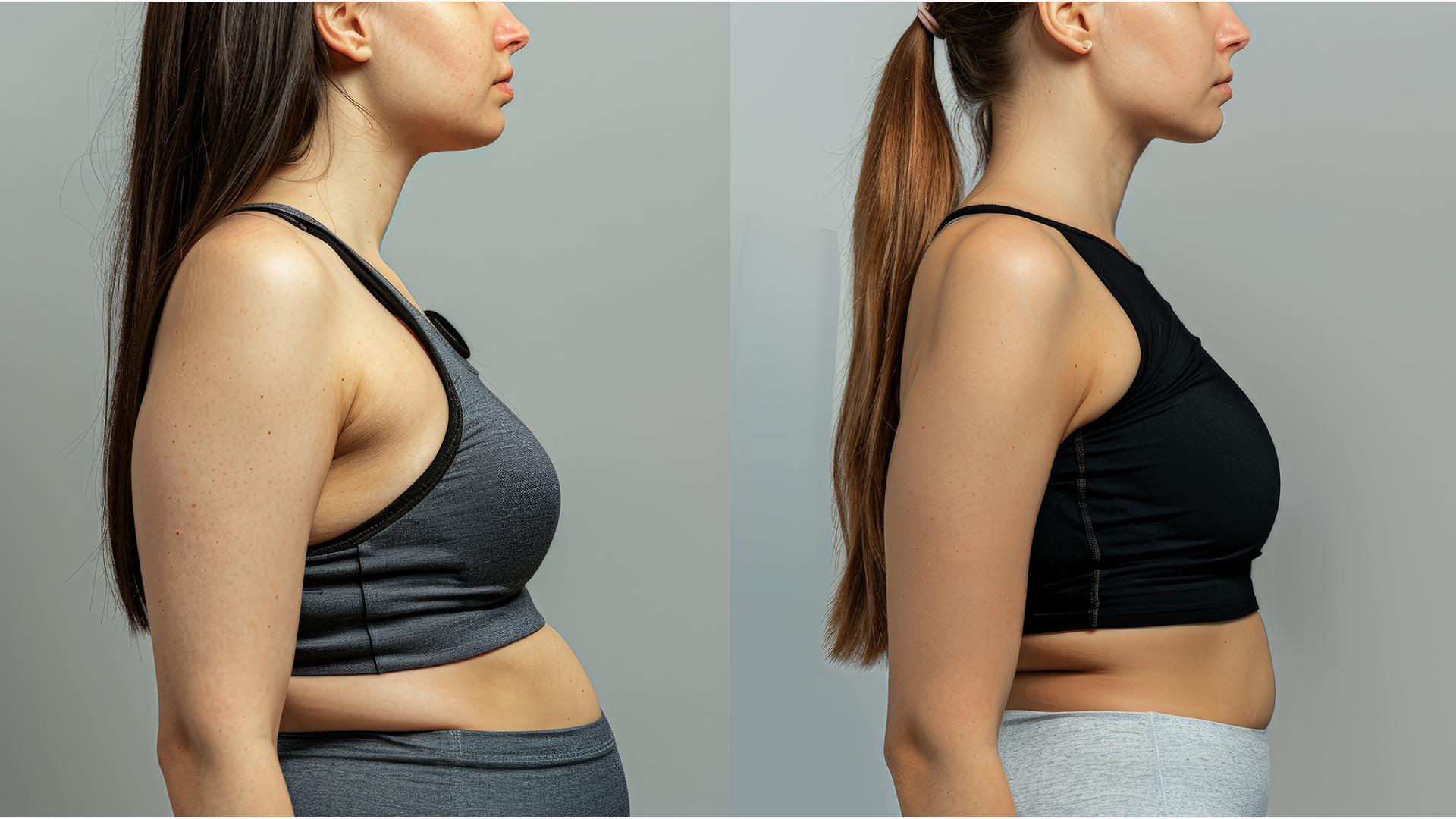What you’ll learn here… |
Want to lose weight at a sustainable rate? We’re here to help you conquer your weight loss goals and crush any obstacles you face on your journey!
Understanding weight loss rates can be tricky—but after reading this, you’ll have enough knowledge to unlock your own ideal weight loss rate.
Maintaining a healthy weight is about improving your boosting your wellbeing and improving your quality of life for a healthier, happier you.
By doing this, you can also lessen the risk of chronic diseases such as heart disease, diabetes, high blood pressure, and high cholesterol. It’s a win-win.
By understanding and applying the principles of a healthy weight loss rate, you can make informed decisions that support long-term health and vitality.
Here, we will dive into weight loss rates and offer insights into how you can manage your weight…the sustainable way.
Ready to explore the best practices for weight loss?
Great. Let’s go.
Understanding a sustainable weight loss rate

A weight loss rate refers to the speed at which you lose body weight over a certain timeframe. This rate is typically measured in pounds or kilograms per week or month.
While weight loss may be your aim, rapid and fast weight loss may not be healthy or sustainable.
Rather than rushing the process, we’re here to help you achieve a healthy weight loss rate, which is essential for sustainable weight management and overall health.
Rapid weight reduction can lead to muscle loss, nutritional deficiencies, as well as other health issues, and is generally harder to maintain in the long run.
When trying to lose weight, what works for one person may not work for the other. So, staying focused on your own path and pouring into yourself will give you the best possible chance of success on your weight loss journey.
Many factors influence your weight loss rate, like your starting weight, age, sex, metabolic rate, physical activity level, and dietary habits.
How much weight loss is sustainable in a month?

Now, one thing everyone wants to know is how much weight they should lose in a month—and we have the answer.
According to healthcare professionals and medical experts, the recommended weight loss rate in a month is typically four to eight pounds (around 1.8 to 3.6 kilograms), which translates to one to two pounds per week.
Achieving this pace of weight loss is generally more manageable and healthier, allowing the body to adjust gradually.
It also reduces the likelihood of adverse effects such as muscle loss, nutritional deficiencies, and metabolic slowdown—which are counterproductive.
Weight loss is more likely to be maintained over time when it’s at a moderate rate. A gradual weight loss approach at a moderate rate encourages the development of healthy habits, like balanced eating and regular physical activity, rather than extreme or restrictive dieting practices.
Sustainable weight loss involves making lifestyle changes that can be maintained indefinitely, rather than short-term fixes that may lead to rapid regain of lost weight once the diet or short training course ends.
A safe weight loss rate paired with gradual weight loss also empowers people to develop and maintain healthier eating and exercise habits, making it more likely that they will keep the weight off in the long run.
Aiming for a steady and moderate weight loss rate is generally the best approach for long-term success and overall health.
Note: Before making a sustainable weight loss plan, please consult a healthcare professional for personalized advice.
How to calculate your weight loss as a percentage

If you need to quantify your weight loss to keep you on track and powered up, you’ll love this.
Here are two ways you can calculate your weight loss rate as a percentage: an equation and a spreadsheet.
Alternatively, you can also browse the internet for an online calculator.
The weight loss percentage equation
If you can calculate your weight loss percentage yourself, give it a go!
The first step is to divide the amount of weight lost in pounds or kilograms by your starting weight in the same units. Secondly, you multiply that answer by 100.
For example, a person's starting weight is 180 pounds and has lost 10 pounds. The calculation below shows that they have lost 5.5% of their body weight.
10 pounds / 180 pounds x 100 = 5.5% of starting body weight lost
Calculating weight loss as a percentage in a spreadsheet
An alternative way to track your weight loss is to record your weight loss percentage on a weekly basis in a spreadsheet, like Microsoft Excel or Google Sheets.
We’d advise you to work with a healthcare professional who can give you advice tailored to you and your health. They can also monitor your achievements and advise you on how to lose weight in the safest, healthiest way possible.
On this journey, you have to exercise patience and be kind to yourself. Weight loss is a process, and it can take a while for you to see the results that you want to see. Nevertheless, you can do it—be unstoppable and positive in your approach.
Keeping track of your weight loss percentage in a spreadsheet can give you a visual presentation of numerical insight to your weight loss progression.
Pros and cons of calculating your weight loss rate

Calculating weight loss rate can offer several benefits—but it does also come with some drawbacks.
Let’s explore.
The pros
One of the key advantages is that it provides a measure of your progress, which can keep you motivated.
Knowing how much weight you’re losing over a specific period helps you set realistic goals and track your achievements. This information can also encourage you to adjust your dietary and exercise habits to ensure their effectiveness.
As well as that, monitoring your rate of weight loss can help prevent unhealthy practices like overly rapid weight loss, which can lead to muscle loss, nutritional deficiencies, and other health issues.
The cons
There are also potential downsides to focusing too closely on weight loss rate—beware! For some people, this close monitoring of weight can lead to an unhealthy obsession with the scale, where minor fluctuations in weight cause significant emotional distress. This can detract from the overall goal of improving health and wellbeing.
Also, scales are not always a direct reflection of if you’ve gained or lost fat or not. Weight can be influenced by various factors such as water retention, muscle gain, and hormonal changes—which may not accurately reflect fat loss or overall fitness improvements.
Consequently, relying solely on weight loss rate might overlook other important indicators of health, such as changes in body composition, fitness levels, and mental well-being—so bear that in mind.
What types of exercise you can do to lose weight sustainably
To lose weight in a sustainable way a combination of cardiovascular exercises, strength training, and flexibility exercises is the way to go.
Aiming for at least 150 minutes of moderate-intensity or 75 minutes of vigorous-intensity aerobic activity per week—along with strength training exercises on two or more days per week—will help you reach your goals.
Let’s get into some examples of workouts you can do…
Cardiovascular (aerobic) exercise

One of the best ways to lose body fat is through steady aerobic exercise—a simple form of low-impact movement that you can do…anywhere.
Brisk walking can increase your heart rate and running is a great exercise for burning calories, losing excess body fat and improving cardiovascular health. Whether you prefer outdoor cycling or using a stationary bike, they’re both effective exercises to help you lose weight.
If you’re aiming for a low-intensity full body workout which gets all muscles engaged, swimming is the perfect option. It’s also easy on the joints and burns a significant number of calories.
Do you like to boogie? If so, dancing can be a high-calorie-burning activity which is fun and enjoyable.
Strength training

Using free weights or machines can help you to build muscle mass, which, in turn, increases your resting metabolic rate.
If you prefer bodyweight exercises, Push-ups, pull-ups, squats, lunges, and planks are excellent for building strength without equipment. You might like to challenge yourself with your bodyweight exercises—and if you do—adding a resistance band will do it.
Top tip: Kettlebell swings and other exercises can provide a combination of cardio and strength training.
High-Intensity Interval Training (HIIT)

HIIT involves short bursts of intense exercise followed by rest or low-intensity exercise. It’s effective for burning calories and improving cardiovascular fitness in a shorter amount of time.
This form of exercise alternates between short bursts of intense activity and brief recovery periods—elevating the heart rate and boosting metabolism.
The intense effort required during HIIT workouts leads to significant calorie expenditure both during and after the exercise. HIIT exercises include sprinting, cycling, or circuit training with bodyweight exercises.
Plus, HIIT helps to preserve muscle mass while promoting fat loss—improving body composition in the process.
Its time efficiency and ability to combine cardiovascular and strength training make it a versatile and accessible option for those seeking to lose weight.
Flexibility and balance exercises

Yoga and Pilates offer numerous benefits for weight loss, mainly through their focus on improving strength, flexibility, and mindfulness.
Yoga: Improves flexibility, reduces stress, and can be a moderate calorie-burning activity
Pilates: Focuses on core strength, flexibility, and overall body conditioning.
Both practices promote the development of lean muscle mass, which boosts metabolism and helps to burn calories more efficiently.
Yoga, with its varied styles, such as Vinyasa and Power Yoga, can provide a vigorous workout that enhances cardiovascular health while reducing stress, a known factor in weight gain.
Pilates, on the other hand, emphasizes core strength and stability, contributing to better posture and overall muscle tone.
The mindful aspect of these disciplines encourages a greater awareness of the body and eating habits, helping you forge healthier lifestyle choices in the process. Plus, the low-impact nature of Yoga and Pilates makes them accessible to a wide range of fitness levels, supporting sustainable and long-term weight management.
Outdoor activities

Hiking, kayaking, and team sports like soccer or basketball can provide a fun and engaging way to stay active.
Combining physical exercise with the invigorating effects of nature can provide a treasure trove of benefits. The natural environment can boost mood and reduce stress levels, which can help curb emotional eating and maintain a positive outlook on fitness goals.
Exposure to sunlight during outdoor activities increases vitamin D levels, which is crucial for overall health and can aid in weight loss.
The variety of terrain and natural obstacles encountered outdoors can enhance coordination and balance—offering a more dynamic and challenging power-up workout.
The enjoyment and variety found in outdoor activities also motivate you to stick with a regular exercise routine, making your weight loss efforts all the more enjoyable.
Weaving a variety of these exercises into your routine can prevent boredom, target different muscle groups, and improve overall fitness.
Consistency is key, so find activities you enjoy and can maintain in the long run. Oh, and adding physical activity into your daily routine—like taking the stairs, walking or biking to work, or doing active chores—can further support sustainable weight loss.
Read: Low-Intensity Workouts: Essential Tips, Ideas & Benefits
The process of losing weight

Embarking on a weight loss journey can be both thrilling and daunting. The excitement of envisioning a healthier, fitter version of yourself is often mingled with the apprehension of the challenges that lie ahead.
By establishing practical and achievable goals from the outset, you can avoid the all-too-common trap of disappointment and instead—stay motivated throughout the process.
As the journey unfolds, you may find yourself experiencing different phases of weight loss.
Initial rapid weight loss: This period often brings about rapid changes, with pounds seemingly melting away and clothes fitting more comfortably. This phase is a time of exhilarating motivation, fueled by the tangible results that act as positive reinforcement for the efforts put in. But it's essential to understand that this rapid progress isn't meant to last forever.
Steady progress phase: Transitioning into this phase, you learn the value of patience, consistency, and perseverance. While the pace of weight loss may slow down during this stage, it is crucial to stay committed to the path chosen.
Plateaus and adjustments: Plateaus are common roadblocks that many encounter during their weight loss journey. It’s important to recognize these moments as opportunities for adjustments—be it in your diet, exercise routine, or mindset—to push past the standstill and continue making progress.
Ultimately, the true essence of a successful weight loss journey lies in the cultivation of sustainable habits.
Longterm success is not achieved through quick fixes or crash diets. Adopting a balanced diet, regular physical activity, and overall healthy lifestyle choices is what will really get you where you need to be.
By embracing these habits as the foundation of their new way of living, you can not only reach your weight loss goals, but also maintain a healthy weight for the rest of your life.
Related: Small Changes To Make To Your Diet And Fitness To Get Summer Ready
Tips on achieving sustainable weight loss

Achieving sustainable weight loss involves making longterm lifestyle changes that promote overall health and well-being.
Although it can be hard to make changes, approaching it with these tips will allow you to do things in a steady manner—you’ve got this!
Make changes that work for your lifestyle
To make sustainable weight loss fit into your lifestyle, start by integrating small, manageable changes rather than overhauling everything at once. Nothing feels worse when you go cold turkey and make a drastic lifestyle change that is short-lived and not sustainable.
But, if you know you work better with structure and following a strict plan, implement necessary changes when you feel you’re ready.
Set realistic goals
Aim for a gradual weight loss of one to two pounds per week. Setting small, achievable goals helps maintain motivation and will keep you going when it counts.
Eat a balanced diet
Focus on a balanced diet rich in whole foods, including plenty of fruits, vegetables, lean proteins, whole grains, and healthy fats.
Avoid highly processed foods and sugary beverages. Adopting a new eating style that promotes weight loss can lead you to adjust your total calorie intake.
Create a healthy relationship with food
Pay attention to portion sizes to avoid overeating. If it would help, use smaller plates and bowls to help control portions visually.
Practice mindful eating by paying attention to hunger and fullness cues. Eat slowly rather than scuffing down your food, as this can help prevent overeating.
Become aware of what you’re putting in your body so you can identify areas for improvement. Avoiding emotional eating and building healthy habits are essential to avoid weight gain.
Avoid rapid weight loss claims
Steer clear of diets that promise quick fixes or require extreme restrictions, as they’re often unsustainable and can lead to nutritional deficiencies and yo-yo dieting.
Crash dieting leads to gaining more weight in the longrun and slows your metabolism. So, forget the fads and focus on living well.
Final thoughts…
In summary, understanding and monitoring your weight loss rate can be a valuable part of your journey to better overall health and wellbeing. By aiming for a healthy weight loss rate, you can enhance your chances of maintaining long-term success and avoiding the pitfalls of rapid weight loss.
Remember, though, that weight loss is a gradual process that requires patience, consistency, and a holistic approach.
Leading with balanced nutrition, regular physical activity, and healthy lifestyle habits will support not only your weight loss goals, but also your overall well-being. While the scale can provide useful feedback—don't let it be your only measure of progress.
Celebrate non-scale victories, like increased energy levels, improved fitness, and better mood, as these are all important indicators of your health.
Stay motivated, stay informed, and most importantly, stay kind to yourself as you navigate your weight loss journey. You can do it.




